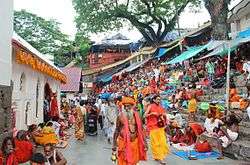Ambubachi Mela
| Ambubachi Mela | |
|---|---|
| Observed by | Hindus |
| Type | Religious, folk |
| Date | Middle of June |
| Frequency | annual |
| Part of a series on the |
| Culture of Assam |
|---|
 |
|
Protohistoric
Ancient Medieval Colonial |
|
|
|
|
|
|
Festivals
|
| Religion |
|
History
Archives
Genres
Institutions Awards Asam Sahitya Sabha Award • Kamal Kumari Foundation Award • Krishnakanta Handique Award |
|
Music and performing arts |
|
The Ambubachi Mela (Pron: ˈæmbʊˌbɑ:ʧɪ /ˌæmbʊˈbɑ:ʧɪ ˈmeɪlə / mi:lə is an annual Hindu mela held at Kamakhya Temple in Guwahati, Assam.[2] This yearly mela is celebrated during the monsoon season that happens to fall during the Assamese month Ahaar, around the middle of June when sun transit to the zodiac of Mithuna, when the Brahmaputra river is in spate.[3][4][5]It is the celebration of the yearly menstruation course of goddess Kamakhya.[3] It is believed that the presiding goddess of the temple, Devi Kamakhya, the Mother Shakti, goes through her annual cycle of menstruation during this time stretch.[4] It is also believed that during the monsoon rains the creative and nurturing power of the 'menses' of Mother Earth becomes accessible to devotees at this site during the mela. There is no idol of the presiding deity but she is worshipped in the form of a yoni-like stone instead over which a natural spring flows.[3][4]
Tantric fertility festival
This mela is also known as Ameti or Tantric fertility festival since it is closely associated with Tantric Shakti cult prevalent in eastern parts of India. Even some Tantric Babas make their public appearances only during these four days. The rest of the year, they remain in seclusion. Some Babas are seen displaying their psychic powers like putting their heads in a pit and stand upright on it, standing on one leg for hours at a stretch.[5]
The mela

The temple remains closed for three days during the mela[3][4] for it is believed that mother earth becomes unclean for three days like the traditional women's menstrual seclusion. During these three days some restrictions are observed by the devotees like not cooking, not performing puja or reading holy books, no farming etc.[3] After three days devi Kamakhya is bathed and other rituals are performed to ensure that the devi retrieves her purity.[4] Then the doors of the temple are reopened[3][4][5] and prasad is distributed.[3][5] On the fourth day the devotees are allowed to enter the temple and worship devi Kamakhya. In 2016, the dates of the Ambubachi festival are scheduled between 22/Jun/2016 till 26/Jun/2016 [4][5]
The prasad
The prasad is distributed in two forms – Angodak and Angabastra. Angodak literally means the fluid part of the body - water from the spring and Angabastra literally means the cloth covering the body - a piece of the red cloth used to cover the stone yoni during the days of menstruation.[3]
Pilgrims

Every year lakhs of pilgrims, starting from Sadhus to householders, from all over India, come to Guwahati to observe this festival. They include Sanyasins, black clad Aghoras, the Khade-babas, the Baul or singing minstrels of West Bengal, intellectual and folk Tantriks, Sadhus and Sadhvis with long matted hair etc.[3][5] Even foreigners from abroad come to seek blessings of mother Kamakhya.[5]
See also
References
- ↑ "Meet the Axomiya Sikhs". The Tribune. Chandigarh. 24 March 2013.
- ↑ "Ambubachi Puja and Mela 2015 at Kamakhya Temple". Retrieved 19 June 2015.
- 1 2 3 4 5 6 7 8 9 Chawla, Janet (Sep 16, 2002). "Celebrating The Divine Female Principle". Boloji.com. Archived from the original on 31 January 2010. Retrieved 24 December 2009.
- 1 2 3 4 5 6 7 "Ambubachi Fair". Bharatonline.com. Archived from the original on 6 January 2010. Retrieved 24 December 2009.
- 1 2 3 4 5 6 7 Admin (Sep 17, 2009). "A Mystic Festival To Draw Thousands". 360degreeworld.com. Retrieved 24 December 2009.
External links
| Wikimedia Commons has media related to Ambubachi Mela. |
- Kamakhya Temple Website
- Ambubachi at Sri Sri Kamakhya Temple: Religious and Socio-Cultural Aspects
- Ambubachi: Celebrating the Menstruation of Mother Earth